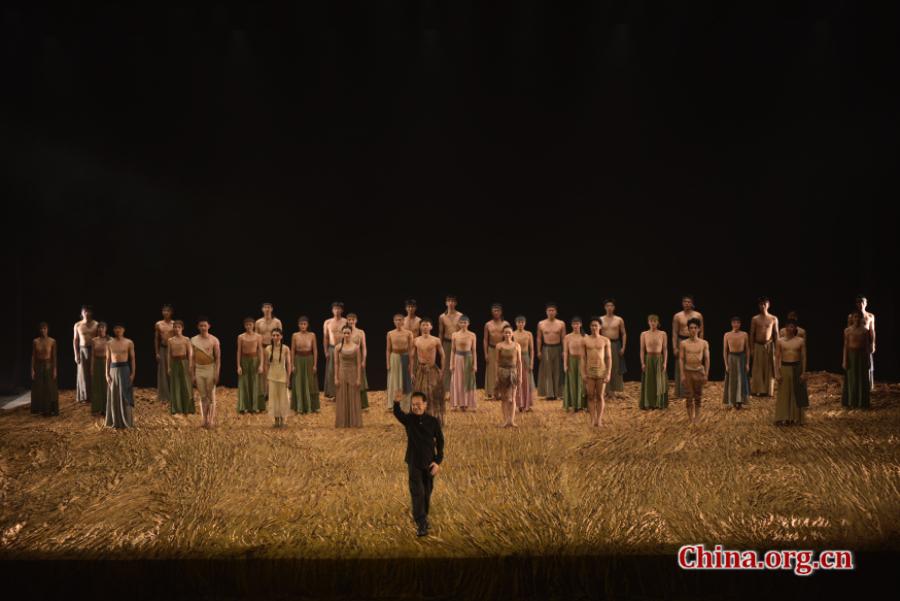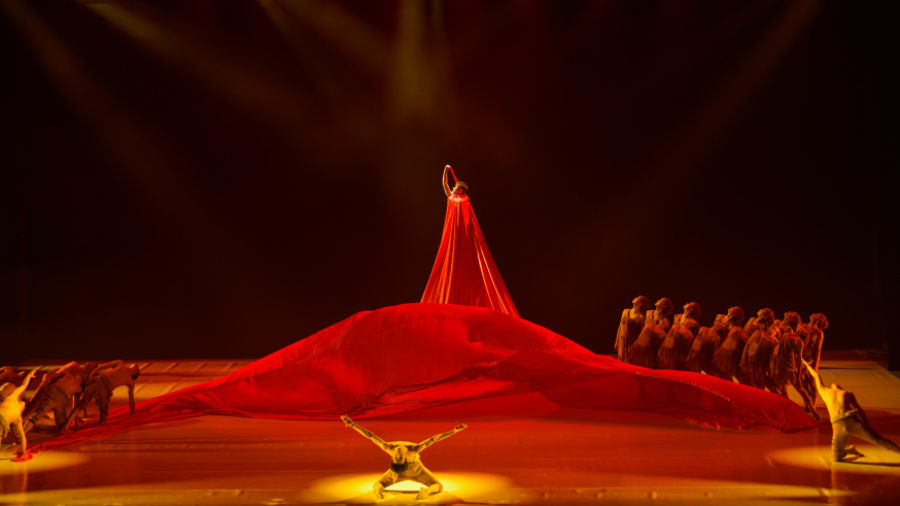
Shanxi Song and Dance Theatre performs "The Yellow River" at the Urumqi Peking Opera House, July 29, 2025. [Photo by Ma Siyuan/China.org.cn]
Dance epic "The Yellow River," directed by renowned Chinese artist Zhang Jigang and created by Shanxi Song and Dance Theatre, was staged at the 7th China Xinjiang International Dance Festival on July 29-30. Marking the 80th anniversary of the victory in the Chinese People's War of Resistance Against Japanese Aggression, the work utilizes the Yellow River as its central image, interpreting the unyielding Chinese national spirit through a unique artistic language.
"The Yellow River" unfolds the spiritual scroll of the Chinese nation in three acts: The first act reproduces the dawn of civilization with primitive and unrestrained dance moves; the second act focuses on the suffering and struggles during the war against Japanese aggression; and the third act outlines the spirit of forging-ahead in the new era with red silk ribbon dancing.

Director Zhang Jigang and performers of "The Yellow River" on stage at Urumqi Peking Opera House, July 29, 2025. [Photo by Ma Siyuan/China.org.cn]
Director Zhang Jigang emphasized that through chapters such as "The Indignation of the Yellow River" and "Defend the Yellow River," the work condenses memories of the war into a spiritual declaration that "the Chinese nation cannot be humiliated."
As a dance epic, "The Yellow River" breaks the boundaries of traditional dance with its subversive stage language. The performers crawl in mud, fight in water currents and perform difficult lifts on a suspended cloth — these unique movements becoming carriers for interpreting the spirit of the Yellow River.
Zhang also explained that dancing on the cloth is a metaphor for the resilience of the Chinese nation, and was designed to let the audience feel the weight of history while evoking a sense of awe.
The fusion of music and dance further highlighted the epic temperament. The passion of the piano concerto interwove with the profoundness of the symphony, forming a perfect dialogue between the "musical" and the "dancing" Yellow River.
Yang Qian, the lead actress who plays the personification of the Yellow River, mentioned that the biggest difference between a dance epic and a traditional dance drama lies in "striking the heart with a five- or six-minute chapter."
Talking about her role, Yang said, "The Yellow River is not a specific river, but a microcosm of thousands of Chinese mothers — having the tenderness of water and the tenacity of the loess land." In the chapter "The Lullaby of the Yellow River," she interpreted the river's nurturing power as the cradle of Chinese civilization with the body language of "taking the sky as a quilt and the earth as a bed."
As a hub on the ancient Silk Road, Xinjiang has always been a fertile ground for the integration of diverse cultures. As Zhang explained, "The simple beauty of Xinjiang forms a wonderful echo with the profound civilization carried by the Yellow River." At the 7th China Xinjiang International Dance Festival, "The Yellow River" and the dance arts of all ethnic groups in Xinjiang shone together, jointly interpreting the diversity and unity of Chinese culture.
Zhang has a deep affection for Xinjiang, recalling how he felt "a peaceful soul as pure as water" when visiting the region's Sayram Lake. In the dance epic, the concept of simplifying plots, intensifying emotions, downplaying regional traits and enhancing international appeal has elevated the Yellow River from a mere river to a symbol of the world's great river civilizations.
By staging the work in Urumqi, the performance served as both a review of the national spirit of the War of Resistance Against Japanese Aggression 80 years ago and a tribute to the present-day cultural integration.


 Share:
Share: 




 京公網安備 11010802027341號
京公網安備 11010802027341號